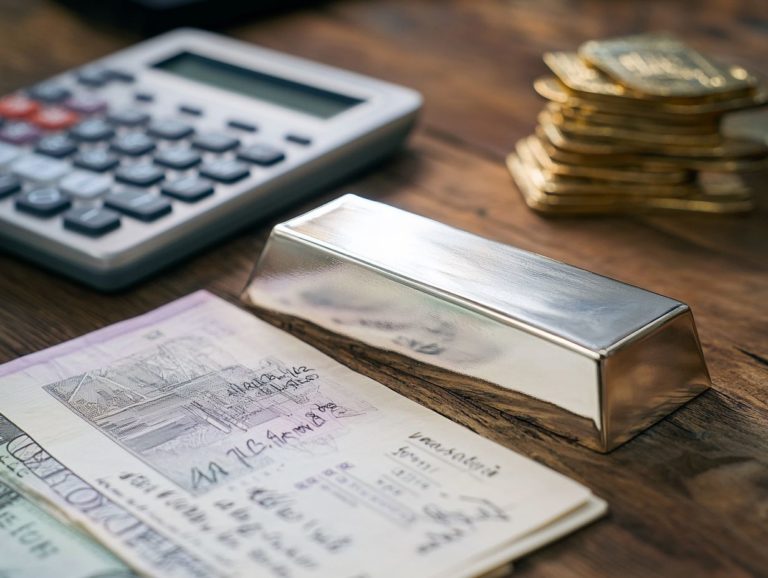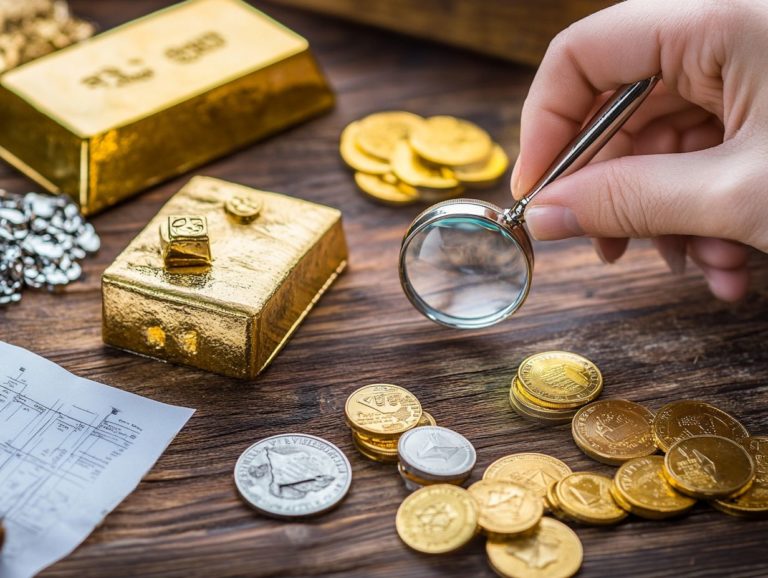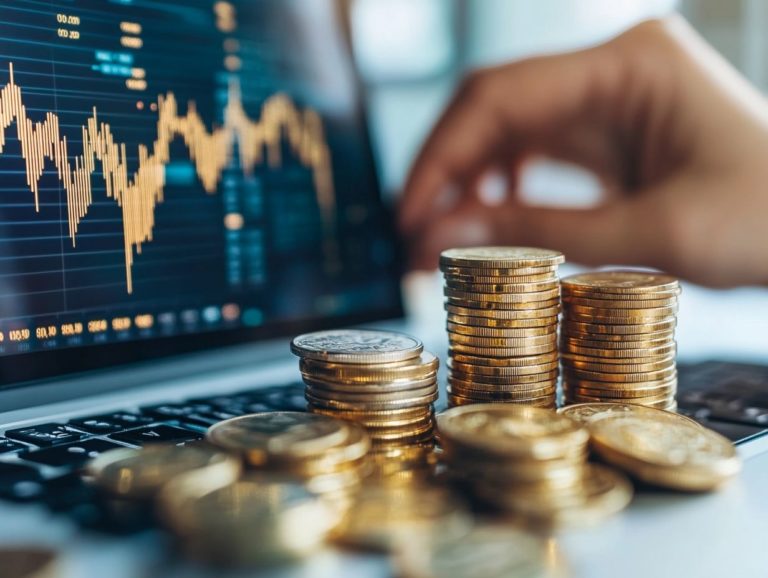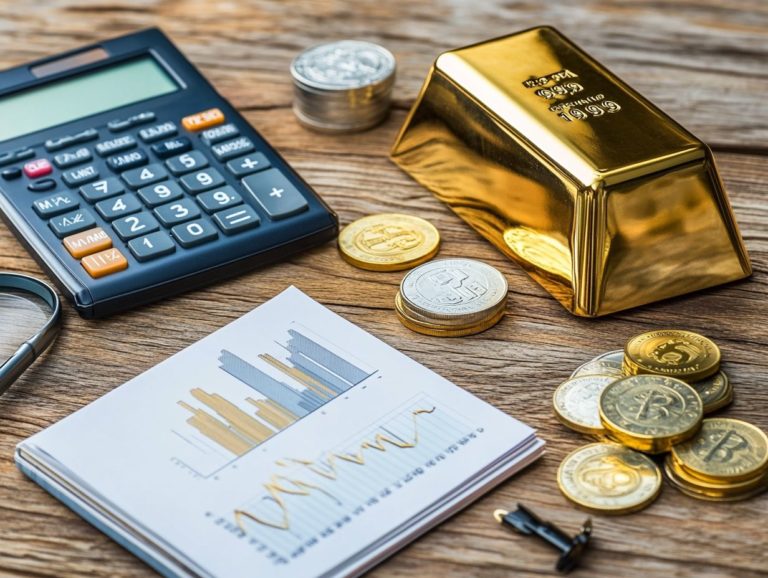Diversifying with Rare Metals: A Smart Move?
In today’s unpredictable market, you re likely looking for effective strategies to safeguard and enhance your wealth.
One option gaining significant attention is rare metals, which provide distinctive benefits for diversification. This article explores rare metals and highlights their advantages in mitigating risk and boosting returns. We will also outline the various types available from precious metals to industrial ones.
You ll find insights into practical investment strategies, potential risks, and tailored recommendations designed to help you navigate this fascinating asset class. Continue reading to determine whether integrating rare metals into your portfolio is the savvy choice you ve been contemplating.
Contents
- Key Takeaways on Rare Metals:
- What are Rare Metals?
- Benefits of Diversifying with Rare Metals
- Types of Rare Metals to Consider
- How to Invest in Rare Metals
- Risks and Considerations
- Expert Recommendations
- Frequently Asked Questions
- What are rare metals and why should I consider diversifying with them?
- How can I invest in rare metals?
- What are the benefits of diversifying with rare metals?
- Are there any risks associated with investing in rare metals?
- How do I determine which rare metals to invest in?
- Can diversifying with rare metals protect me from economic downturns?
Key Takeaways on Rare Metals:
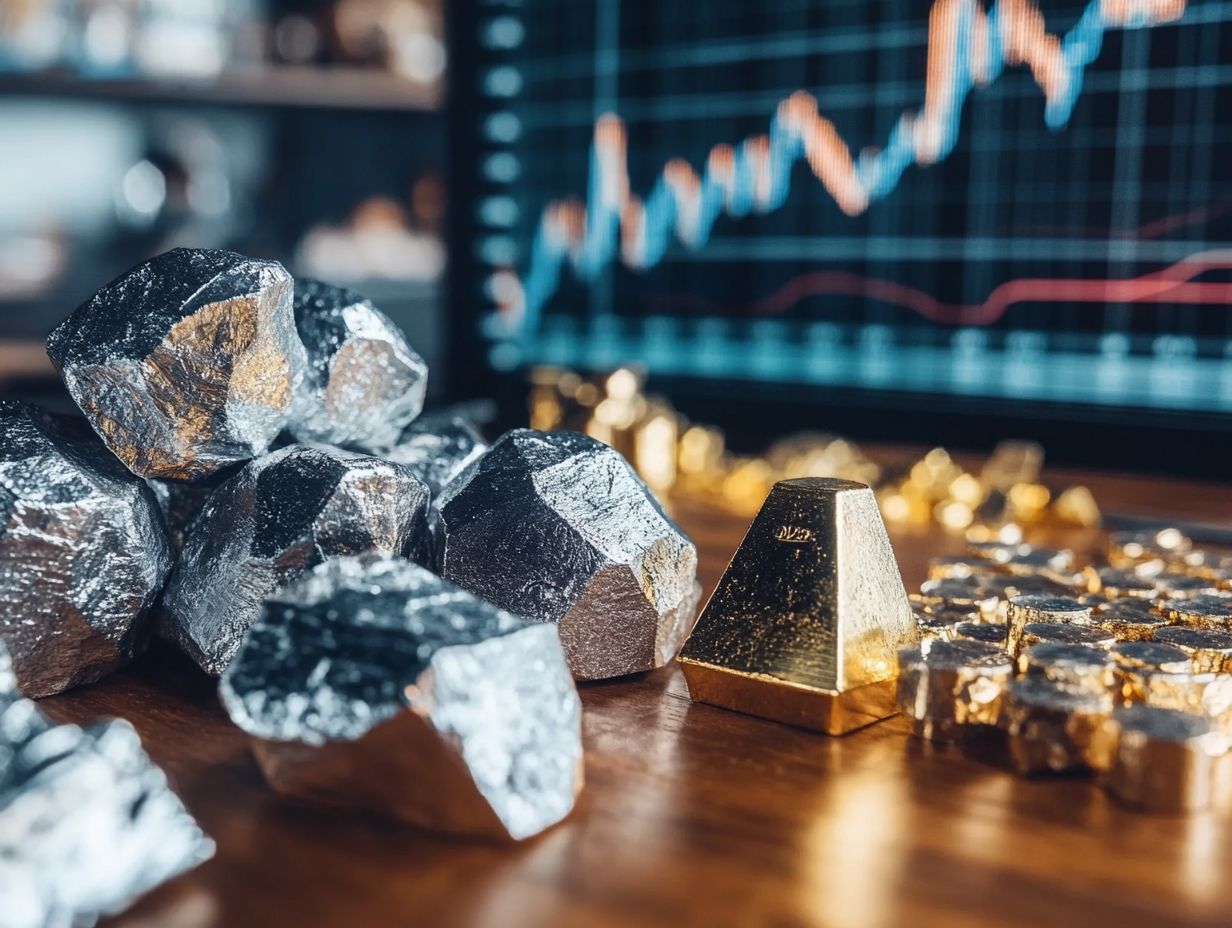
Diversifying with rare metals can reduce risk and enhance returns. Explore both precious and industrial options, but always understand the risks involved.
What are Rare Metals?
Rare metals, commonly known as rare earth metals, comprise a distinct group of 17 chemical elements, including lanthanides and actinides. These elements play a crucial role in various high-tech applications and industrial products.
Their unique properties make them critical for manufacturing electronics, advancing renewable energy technologies, and enhancing defense systems. This establishes them as vital commodities in the global market.
Understanding their extraction processes and refining capabilities is essential for appreciating their economic significance and the challenges faced by mining companies globally.
Benefits of Diversifying with Rare Metals
Diversifying your investments with rare metals presents a compelling opportunity for investors looking to navigate market volatility and establish a robust inflation hedge beyond traditional precious metals like gold and silver.
As rare earth metals rise in prominence, driven by their crucial role in high-tech products and industrial applications, they become increasingly appealing as part of a well-rounded diversification strategy.
This approach is designed to mitigate the risks associated with economic downturns, making it a smart consideration for your investment portfolio.
Reducing Risk and Increasing Returns
Investing in rare metals can effectively reduce risk and amplify returns. These materials act as a reliable buffer against market volatility and global political issues that frequently trouble traditional assets.
Exceptional materials like platinum and palladium serve as a hedge during economic downturns, making them attractive additions to a well-rounded portfolio. Historical data from previous financial crises, including the 2008 recession, shows that rare metals often outperform conventional stocks and bonds during turbulent times.
For instance, while equities were nosediving, investments in precious metals either retained their value or appreciated, underscoring the resilience of these assets.
By incorporating asset allocation strategies which help spread investments to manage risk better investors can potentially lessen losses and bolster the overall stability of their portfolios.
Types of Rare Metals to Consider

When contemplating investing in rare metals, it is crucial to distinguish between the various types namely, rare earth metals and traditional precious metals. Each category serves distinct roles in industrial applications and technological advancements.
For example, rare earth elements such as neodymium and dysprosium are critical for renewable energy technologies. In contrast, precious metals like gold and platinum provide a sense of stability and value retention appealing in an investment portfolio.
Precious Metals vs. Industrial Metals
Precious metals, such as gold and silver, often stand out as investments that are considered stable in times of market trouble. Meanwhile, industrial metals, including rare earth metals, are crucial in the production of high-tech and industrial products.
Observe the contrasting nature of these metals in their market behaviors. Precious metals appreciate during economic uncertainty as investors seek stability.
Industrial metals, on the other hand, are heavily influenced by economic growth and are essential for manufacturing processes, including electronics and renewable energy technologies. Consider rare earth metals like neodymium and dysprosium; they play a vital role in producing powerful magnets for electric vehicles and smartphones, highlighting their unique applicability in rapidly evolving industries.
This distinction emphasizes each type’s investment characteristics and underscores their integral role in shaping modern economies.
How to Invest in Rare Metals
Investing in rare metals offers a variety of pathways. You might consider direct investments in mining companies, exchange-traded funds (ETFs) which are investment funds traded on stock exchanges, similar to stocks or broader market strategies that tap into the economic significance of these invaluable resources.
As the demand for rare earth metals continues to rise, you ll find numerous opportunities to capitalize on this trend while effectively managing the risks tied to market volatility.
Options for Investing in Rare Metals
If you re an investor looking to tap into the potential of rare metals, you have various enticing options at your fingertips. You might consider purchasing stocks in prominent mining companies like MP Materials or Freeport-McMoRan, or perhaps explore ETFs such as the VanEck Rare Earth ETF.
These stocks offer substantial growth potential and serve as a vital link to the technology sector. This is because rare earth metals are essential in producing everything from smartphones to electric vehicle batteries.
With the increasing emphasis on green technologies and renewable energy, the demand for these metals is expected to surge. Investing in ETFs that focus on rare earth elements provides a savvy alternative to diversify your portfolio while also mitigating certain company-specific risks.
By examining the performance of key players in this sector and understanding how their operations integrate into the broader global supply chain, you can make informed investment decisions that align seamlessly with current technological trends.
Risks and Considerations
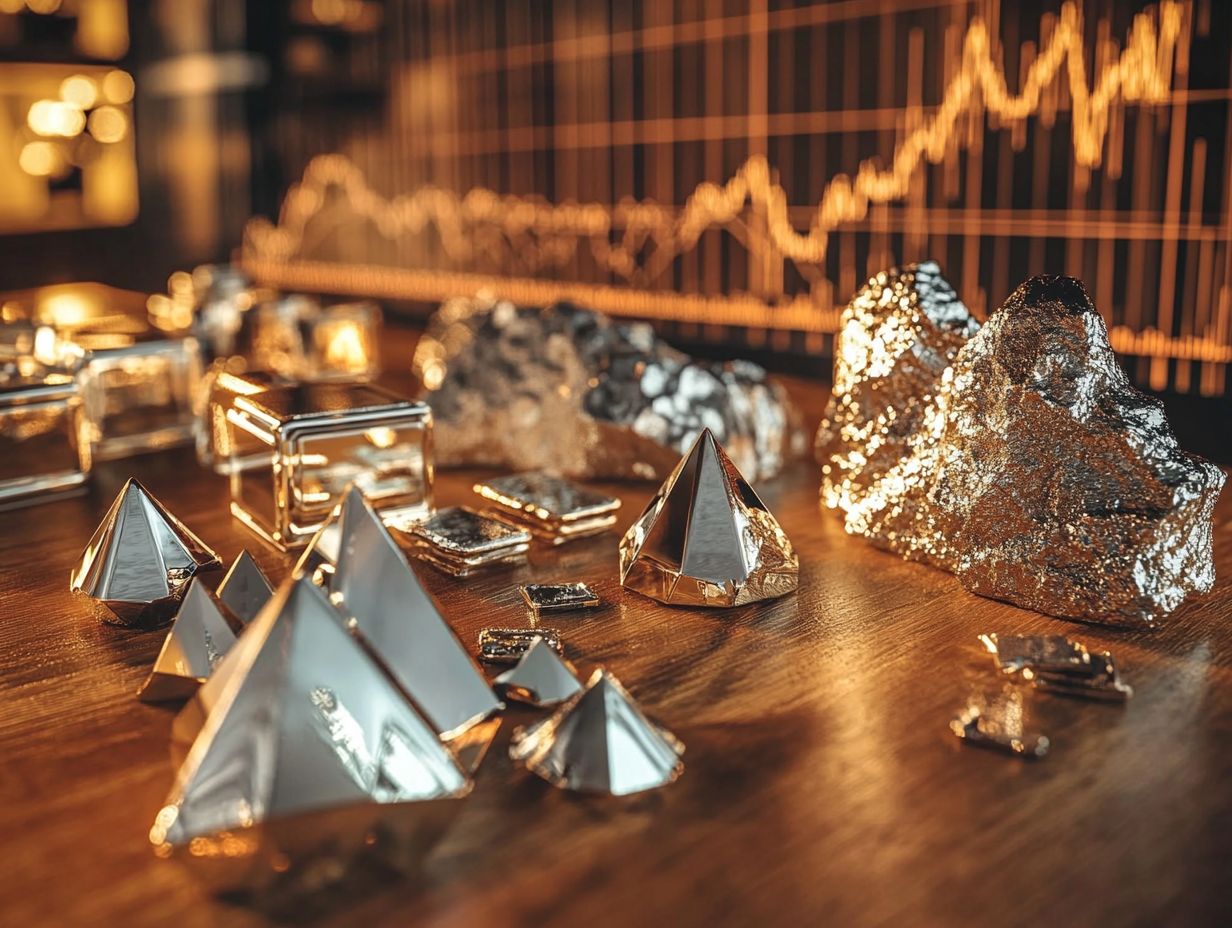
Investing in rare metals is an exciting opportunity that could yield amazing returns, yet it comes with a unique set of risks and considerations to navigate. Be aware of supply chain challenges, environmental impacts, and geopolitical risks that can significantly influence market dynamics and pricing.
Understanding these factors is essential for maximizing your investment potential and effectively leveraging rare metals as a hedge against inflation.
Potential Risks and Mitigation Strategies
When considering an investment in rare metals, it’s essential to be aware of the potential risks. These include supply chain challenges and geopolitical factors that can create market volatility and affect your returns.
These challenges are not just abstract notions; they can manifest as rising costs and unexpected shortages. For example, the 2010 export ban on rare earth metals by China sent shockwaves through global supplies, leading to a dramatic price surge and prompting nations like the United States to rethink their sourcing strategies.
You can mitigate these risks by diversifying your portfolio to encompass various types of rare metals. Stay well-informed about global trade policies and partner with suppliers who prioritize sustainable practices to enhance your investment security. Investing in companies with strong geopolitical risk assessments provides extra security in this unpredictable market.
Expert Recommendations
Expert recommendations for investing in rare metals highlight the crucial need for a diversified portfolio. By incorporating a range of assets, you can take full advantage of the unique investment opportunities these metals offer while simultaneously strengthening your defense against inflation.
Advice from Financial Experts
Financial experts recommend that you spread out your investments by including rare metals alongside traditional assets like precious metals. This approach can significantly enhance the resilience of your collection of investments and improve potential returns.
Advisers suggest that incorporating rare metals such as palladium and platinum can really boost your investment strategy due to their unique market dynamics and strong industrial demand. It s crucial to use strong risk management techniques, ensuring that your exposure to rare metals remains within a manageable percentage of your overall collection of investments.
By following these strategies, you can not only mitigate risk but also seize emerging market trends that could substantially elevate your investment outcomes. Don t miss out! Investing in rare metals can really set you apart in today s market.
Frequently Asked Questions
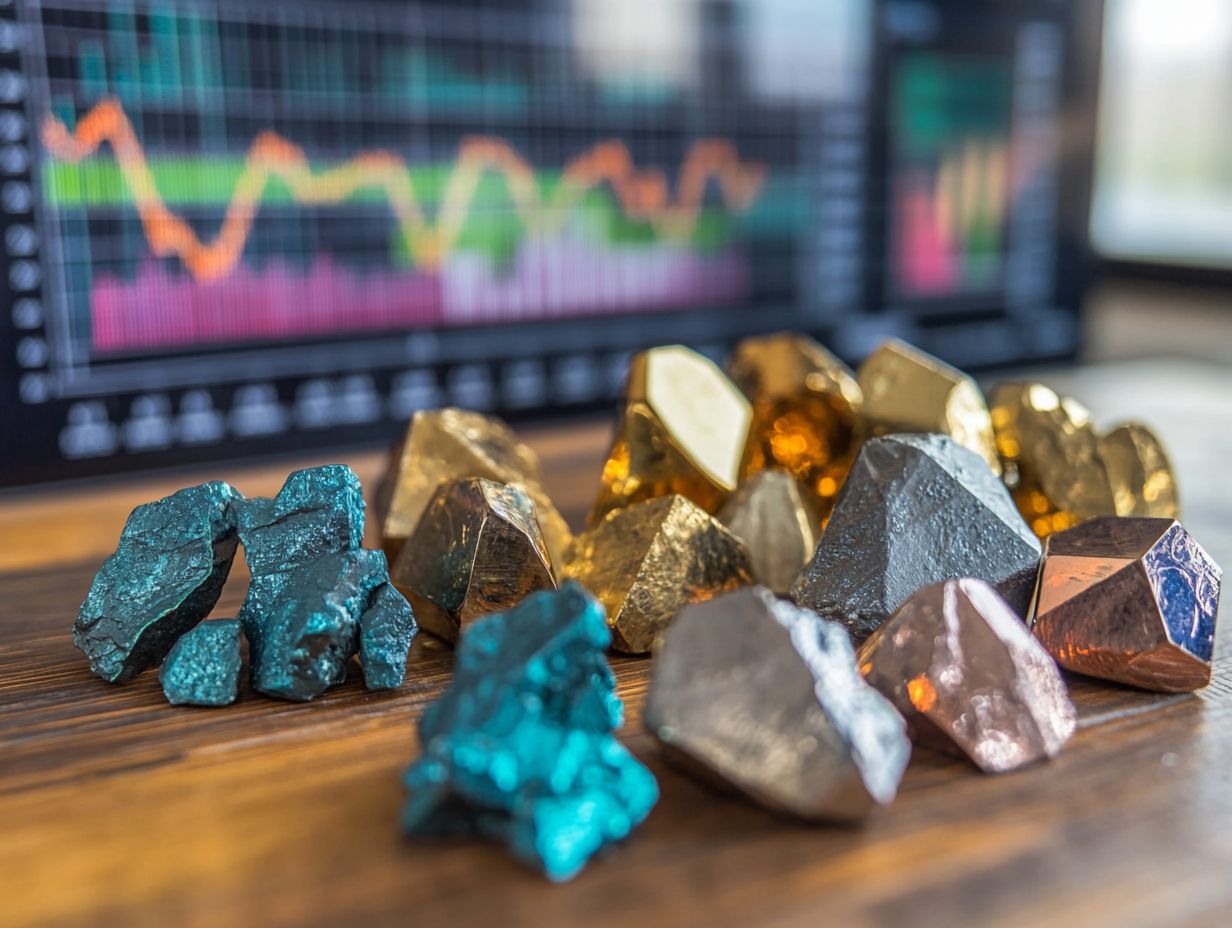
Here are some common questions about investing in rare metals.
What are rare metals and why should I consider diversifying with them?
Rare metals, also known as strategic metals, are a group of chemical elements that are scarce and have high economic value due to their use in various industries. Diversifying with rare metals can provide protection against market volatility and inflation, making it a smart move for investors.
How can I invest in rare metals?
There are several ways to invest in rare metals, including buying physical metals such as gold, silver, and platinum, as well as investing in mining companies or exchange-traded funds (ETFs) that specialize in rare metals.
What are the benefits of diversifying with rare metals?
In addition to providing protection against market fluctuations, rare metals can also offer portfolio diversification, potential for higher returns, and a hedge against inflation and currency devaluation.
Are there any risks associated with investing in rare metals?
As with any investment, there are risks involved in investing in rare metals. These include price volatility, geopolitical risks, and potential for fraud or counterfeiting. It’s important to do thorough research and consult with a financial adviser before making any investment decisions.
How do I determine which rare metals to invest in?
The decision on which rare metals to invest in should be based on your individual financial goals and risk tolerance. It’s important to consider factors such as supply and demand, industrial uses, and historical performance when choosing which rare metals to add to your portfolio.
Can diversifying with rare metals protect me from economic downturns?
Rare metals have historically held their value and even increased in price during economic downturns. This makes them a potential safe-haven asset for investors looking to protect their portfolios during times of market volatility or recession.










